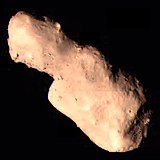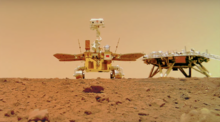Planetary Exploration of China
'Questions to Heaven'), is the robotic interplanetary spaceflight program conducted by the China National Space Administration (CNSA).
The program aims to explore planets of the Solar System, starting from Mars, and will be expanded to Jupiter and more in the future.
[6] China began its first interplanetary exploration attempt in 2011 by sending Yinghuo-1, a Mars orbiter, in a joint mission with Russia.
[7] On December 13, 2012, the Chinese lunar probe Chang'e 2 made a flyby of the asteroid 4179 Toutatis in an extended mission.
[10] On April 24, 2020, Planetary Exploration of China was formally announced by CNSA, along with the name "Tianwen" and emblem of the program.
[4] The Tianwen-1 was inserted into Mars orbit in February 2021 after a seven-month journey, followed by a successful soft landing of the lander and Zhurong rover on May 14, 2021.
The name represents the Chinese people's relentless pursuit of truth, the country's cultural inheritance of its understanding of nature and universe, as well as the unending explorations in science and technology.
[3] The emblem of PEC and its missions consist of eight planets in the Solar System and their orbits in the shape of the Latin letter 'c', referring to China, cooperation, and the cosmic velocity required to undertake planetary exploration.
[18] On July 23, 2020, the Tianwen-1 spacecraft stack, consisting of an orbiter, a lander, a rover, deployable and remote cameras launched from Wenchang, marking the beginning of the mission.
During this journey it deployed the remote selfie camera on June 1, 2021, whose imagery confirmed the successful landing of the rover and lander.
The mission to return samples from a near-Earth asteroid and to orbit a main-belt comet is planned to be conducted around 2025, according to CNSA announcement on June 12, 2021.
This mission is expected to last 3-4 years and include the following payloads, a Microwave Radiometric Sounder (MRS), Polarimetric Synthetic Aperture Radar (PolSAR), and Ultraviolet-Visible-Near Infrared Multispectral Imager (UVN-MSI).









